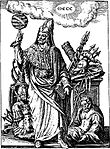هرمتیکا
| هرمسیه |
|---|
 |
| اسطورهشناسی |
| متون هرمس |
|
"Three Parts of the Wisdom of the Whole Universe" |
| جنبشها |
| فرقهها |
| موضوعات |
| اشخاص |
هرمتیکا (به انگلیسی: Hermetica)، متون منسوب به شخصیت افسانهای هلنیستی، هرمس تریسمجیستوس است که تلفیقی از خدای یونانی هرمس و خدای مصری تحوت است.[۱] این متون ممکن است از نظر محتوا و هدف بسیار متفاوت باشند، اما به دو دسته اصلی تقسیم میشوند، هرمتیکای «فنی» و «دینی-فلسفی».
مقوله هرمتیکای فنی شامل انواع گستردهای از رسالههای مربوط به طالع بینی، پزشکی و داروسازی، کیمیاگری و جادو است، که قدیمیترین آنها به زبان یونانی نوشته شدهاست و ممکن است به قرن دوم یا سوم قبل از میلاد بازگردد.[۲] بسیاری از متون متعلق به این دسته بعدتر به عربی و لاتین ترجمه شدند و در طول قرنها مورد بازبینی و گسترش قرار گرفتند. برخی از آنها نیز در اصل به زبان عربی نوشته شدهاند، اگرچه در بسیاری از موارد وضعیتشان بهعنوان یک اثر اصلی یا ترجمه نامشخص است.[۳] این متون هرمسی عربی و لاتین در سراسر قرون وسطی کپی شدند (مشهورترین نمونه لوح زمرد است).
هرمتیکای «دینی-فلسفی» مجموعهای منسجم از رسالههای دینی-فلسفی است که بیشتر در قرن دوم و سوم نوشته شدهاند. یک قرن بعد از میلاد[۴] بر رابطه بین انسانها، کیهان و خدا متمرکز هستند (بنابراین انسانشناسی فلسفی، کیهانشناسی و الهیات را با هم ترکیب میکنند). بسیاری از آنها نیز پندهای اخلاقی هستند که خواستار راهی برای زندگی هستند که منجر به تولد دوباره روحانی و در نهایت الوهیت در قالب یک صعود بهشتی میشود.[۵] رسالههای این دسته احتمالاً همه در اصل به زبان یونانی نوشته شدهاند، اگرچه برخی از آنها فقط در ترجمههای قبطی، ارمنی یا لاتین باقی ماندهاند.[۶] در طول قرون وسطی، بسیاری از آنها فقط در دسترس دانشمندان بیزانسی بود (یک استثنا: اسکلپیوس، که در ترجمه لاتین اولیه باقی ماندهاست)، تا اینکه مجموعهای از رسالههای هرمتیک یونانی معروف به متون هرمس توسط دانشمندان دوره رنسانس مارسیلو فیچینو (۱۴۳۳–۱۴۹۹) و لودوویکو لازارلی (۱۴۴۷–۱۵۰۰) به لاتین ترجمه شد.[۷]
جستارهای وابسته
[ویرایش]پانویس
[ویرایش]- ↑ A survey of the literary and archaeological evidence for the background of Hermes Trismegistus in the Greek Hermes and the Egyptian Thoth is found in (Bull 2018).
- ↑ (Copenhaver 1992); (Bull 2018). Garth Fowden is somewhat more cautious, noting that our earliest testimonies date to the first century BCE (see (Fowden 1986)).
- ↑ (Van Bladel 2009).
- ↑ (Copenhaver 1992); (Bull 2018). The sole exception to the general dating of c. 100–300 CE is The Definitions of Hermes Trismegistus to Asclepius, which may date to the first century CE (see (Bull 2018), referring to (Mahé و 1978–1982); cf. (Mahé 1999)). Earlier dates have been suggested, most notably by Flinders Petrie (500–200 BCE) and Bruno H. Stricker (c. 300 BCE), but these suggestions have been rejected by most other scholars (see (Bull 2018)).
- ↑ (Bull 2018).
- ↑ E.g. , The Discourse on the Eighth and Ninth (Coptic; preserved in the Nag Hammadi library, which consists entirely of works translated from Greek into Coptic; see (Robinson 1990)), the Definitions of Hermes Trismegistus to Asclepius (Armenian; see (Bull 2018)), and the Asclepius (also known as the Perfect Discourse, Latin; see (Copenhaver 1992)).
- ↑ (Copenhaver 1992); (Hanegraaff 2006).
منابع
[ویرایش]- Van Bladel, Kevin (2009). The Arabic Hermes: From Pagan Sage to Prophet of Science. Oxford: Oxford University Press. doi:10.1093/acprof:oso/9780195376135.001.0001. ISBN 978-0-19-537613-5.
- Mahé, Jean-Pierre (1999). "The Definitions of Hermes Trismegistus to Asclepius". In Salaman, Clement; van Oyen, Dorine; Wharton, William D.; Mahé, Jean-Pierre (eds.). The Way of Hermes. London: Duckworth Books. pp. 99–122. ISBN 978-0-89281-186-1.
- Bull, Christian H. (2018). The Tradition of Hermes Trismegistus: The Egyptian Priestly Figure as a Teacher of Hellenized Wisdom. Religions in the Graeco-Roman World: 186. Leiden: Brill. doi:10.1163/9789004370845. ISBN 978-90-04-37084-5. S2CID 165266222.
- Hanegraaff, Wouter J. (2006). "Lazzarelli, Lodovico". In Hanegraaff, Wouter J. (ed.). Dictionary of Gnosis and Western Esotericism. Leiden: Brill. pp. 679–683. ISBN 9789004152311.
- Copenhaver, Brian P. (1992). Hermetica: The Greek Corpus Hermeticum and the Latin Asclepius in a New English Translation, with Notes and Introduction. Cambridge: Cambridge University Press. ISBN 0-521-42543-3.
- Fowden, Garth (1986). The Egyptian Hermes: a Historical Approach to the Late Pagan Mind. Cambridge University Press. ISBN 0-521-32583-8. OCLC 13333446.
- Mahé, Jean-Pierre (1978–1982). Hermès en Haute-Egypte. Vol. I–II. Quebec: Presses de l'Université Laval. ISBN 978-0-7746-6817-0.
- Robinson, James M. (1990). The Nag Hammadi Library in English. 3th, revised edition. New York: HarperCollins. ISBN 978-0-06-066935-5.
پیوند به بیرون
[ویرایش]- The Gnostic Society Library hosts translations of the Corpus Hermeticum, the Asclepius, the Stobaean excerpts, and some ancient testimonies on Hermes (all taken from Mead, George R. S. 1906. Thrice Greatest Hermes: Studies in Hellenistic Theosophy and Gnosis. Vols. 2-3. London: Theosophical Publishing Society; note that these translations are outdated and were written by a member of the Theosophical Society; modern scholarly translations are found above), as well as translations of the three Hermetic treatises in the Nag Hammadi findings (reproduced with permission from the translations prepared by James Brashler, Peter A. Dirkse and Douglas M. Parrott as originally published in: Robinson, James M. 1978. The Nag Hammadi Library in English. Leiden: Brill).
